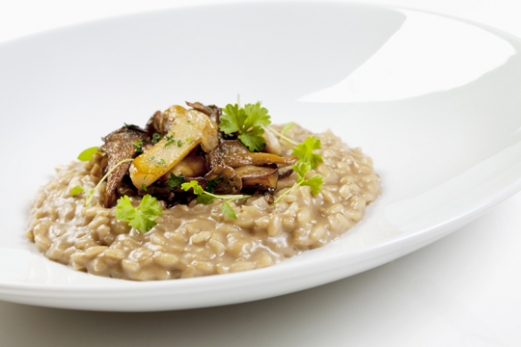
Reducing Food Waste in Foodservice
October 16, 2018 by Doreen Garelick, Dietetic Intern
Our intern Doreen attended a food waste summit for restaurants and compiled these tips to help food service operators redirect…

A creamy, wild mushroom risotto made with arborio rice, roasted mushroom purée and black truffle oil, garnished with wild mushrooms.
Notes:
All dishes are comprised of three macronutrients - carbohydrates, protein and fat. These macronutrients are the main sources of energy in our diet and all are necessary for overall health.
* For information about calorie and food group needs for your specific diet, visit the USDA’s MyPlate Daily Food Plan website.
| Saturated | 3g |
| Unsaturated | 11g |
The USDA recommends 20-35% of calories come from fat; however, there are good fats and bad fats. Unsaturated fats are considered good fats and are found in nuts, seeds, most vegetable oils, poultry, and fish. Olive oil is largely monounsaturated and a key component to the Mediterranean diet pyramid. Omega-3s are polyunsaturated fats and found in soy, walnuts, flax and chia seeds, fish and shellfish. Saturated fats are not as good for us and therefore should not represent more than 10% of total calories in our diet. Sources of saturated fats include red meat, high-fat dairy (butter, cream, cheese, etc.), palm and coconut oil.
SPE promotes the use of ingredients with higher amounts of unsaturated fat than saturated fat. The fat in this dish comes from the milk,oil and cheese. 8% of calories come from saturated fat.
| Total | 9g |
The USDA recommends 10-35% of calories come from protein; however, some protein sources are better for you than others. Proteins from lean meats, poultry, seafood and low-fat dairy provide the essential amino acids your body needs without too much additional saturated fat. Plant-based protein sources such as legumes, nuts and soy are also good choices with higher quality fats.
| Added Sugar | 0g |
| Natural Sugar | 3g |
| Fiber | 2g |
| Other | 35g |
Carbohydrates are called many things: starch, sugar and fiber, complex and simple. They mainly come from grains, legumes, fruits, vegetables, dairy and sweeteners. The USDA recommends 45-65% of calories come from carbohydrates. In SPE, we target sources of carbohydrates that offer more than just quickly-absorbed calories such as intact or unrefined grains, legumes and whole fruits and vegetables.
Sugars are naturally occurring in grains, fruits and dairy and added sugars come from sweeteners such as corn syrup, cane and beet sugar, honey, agave, maple syrup and molasses, among others. The sugars in this dish come from the rice and dairy. There is no added sugar in this dish.
Below are descriptions of a handful of vitamins and/or minerals found in this dish. The percent of the daily value recommended by the USDA’s Dietary Guidelines for most adults is shown for each vitamin or mineral listed.
The calcium in this dish comes from the dairy. Calcium is the structural component of bones and teeth and is involved in muscle contraction and blood clotting.
The selenium in this dish comes from the mushrooms. Selenium is a mineral that protects cells by neutralizing free radicals.
The copper in this dish comes from the mushrooms. Copper is a mineral important in energy production and a component of many different enzymes.
** Recommended Daily Amount for most adults.
The USDA Dietary Guidelines recommend eating a variety of vegetables and fruits daily and replacing refined grains with whole grains. The recommended number of servings of fruits, vegetables and whole grains vary based on your specific needs and can be found at the USDA’s MyPlate Daily Food Plan website. The chart below shows the numbers of servings of each food in this dish, with each icon representing a serving.



 = 1 serving of fruit (1/2 cup).
= 1 serving of fruit (1/2 cup).
 = 1 serving of vegetables (1/2 cup).
= 1 serving of vegetables (1/2 cup).
 = 1 serving of whole grains (1 oz.).
= 1 serving of whole grains (1 oz.).
We strive to provide accurate nutrition information, however variations in nutritional content of a dish may occur due to the made-to-order nature of restaurant dishes.